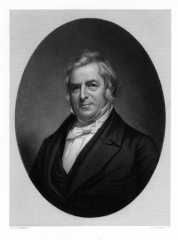seem to appeal to them but in 1863 these gentlemen and their brother, Robert, proposed that the University and the Education Society attempt to raise $70,000 and offered to match any sum collected up to $30,000. Of the total amount secured, about $15,000 was used to cancel the Society’s debt, $5,000 invested for the use of the library, and the balance, some $43,000 added to the endowment.
The largest single donation was received in 1865 when James B. Colgate and John B. Trevor gave $70,000. They provided that $40,000 be designated the Trevor Education Fund, the income to be used for scholarships for Civil War veterans or their sons, and the remainder to be set aside as a fund for the expenses of the Presidency. The next year they made another gift of $10,000 to constitute an investment fund for campus improvements. Mr. Colgate and Mr. Trevor were partners in James B. Colgate and Company, a large brokerage firm with offices in New York, Baltimore, and Washington. They dealt also in precious metals, and during the Civil War Mr. Colgate assisted the Federal government in maintaining its gold reserve. In addition to contributing to Madison University, Mr. Trevor was a generous benefactor to the University of Rochester.
By 1869 the University had an endowment of more than $180,000 and no indebtedness. Contributions from the churches for current expenses of the Education Society increased from less than $1,000 in 1865 to nearly $13,000, some four years later. To augment the existing University funds and to provide for repairs and new equipment, Treasurer Spear and others, in 1868, launched a successful campaign for a $100,000 “Jubilee Offering.” There were now ample resources for future expansion.
The campus in the 1850’s and ’60’s was still as rural as it had always been. Except for paths flanked by beautiful shade trees, every acre was either “plowed, mowed, or pastured.”
An ugly unpainted board fence enclosed the grounds and broad stretches of meadow land which extended in almost every direction over the hills invited youths, disgusted with dull textbooks, for long walks on bright afternoons. In 1851 the students voluntarily laid a mile of hemlock plank walk from the foot of the hill to Broad Street and from the Boarding Hall to the Baptist meeting house and lined each side with maples. Their efforts, coming at a time when every gesture of confidence in the University strengthened morale, gained them the Trustees’ sincere appreciation.





